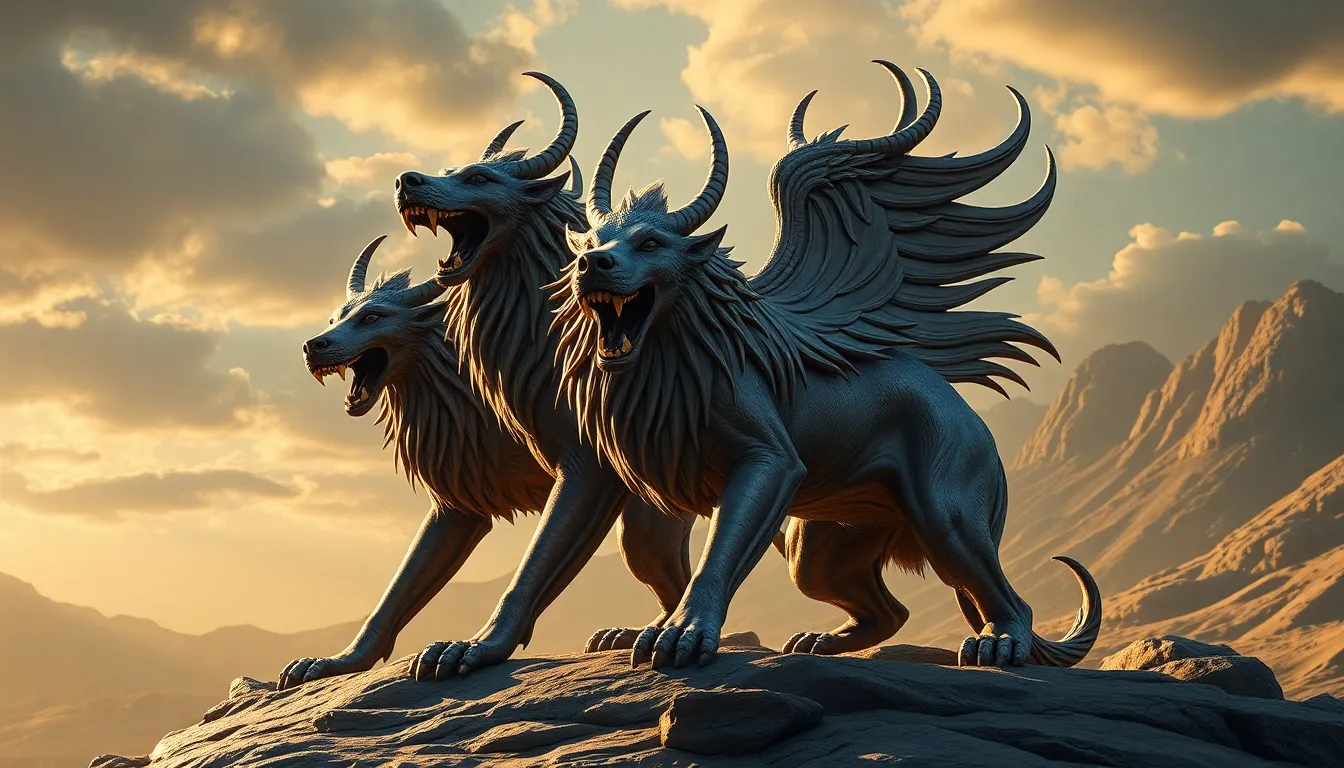Cerberus: The Three-Headed Guardian and His Mythical Legacy
I. Introduction
Cerberus, the formidable three-headed dog of Greek mythology, serves as one of the most iconic figures associated with the Underworld. Known for his fierce loyalty to Hades, the god of the dead, Cerberus embodies the boundary between the living and the dead. His representation in ancient texts and artworks has solidified his importance in both literature and culture, making him a lasting symbol of the mythological realm.
This article aims to delve into the origins, characteristics, and cultural significance of Cerberus, exploring his role in mythology and his impact on modern interpretations.
II. Origins of Cerberus
A. Birth and lineage of Cerberus
Cerberus was born from the union of Echidna, a monstrous half-woman, half-snake creature, and Typhon, a fearsome giant and one of the most dreadful beings in Greek mythology. This lineage places Cerberus among a host of other legendary monsters, including the Chimera and the Hydra.
B. Early mentions in ancient texts
Cerberus is mentioned in several ancient sources, including Hesiod’s “Theogony” and Homer’s “Odyssey.” In these texts, he is primarily depicted as the guardian of the Underworld, ensuring that no souls escape to the land of the living.
III. Description and Characteristics
A. Physical appearance of Cerberus
Cerberus is typically described as having three ferocious heads, each representing a different aspect of his personality: the past, present, and future. His appearance is often enhanced by various serpent-like features, making him a terrifying sight for any who dare approach the Underworld.
- Three Heads: Each head is said to have its own distinct personality—one is fierce, one is loyal, and one is cunning.
- Serpentine Features: Cerberus is often depicted with a snake-like tail and snakes protruding from his back, adding to his fearsome image.
- Claws and Eyes: His claws are sharp and deadly, while his eyes burn with an intense ferocity, instilling fear in all who gaze upon him.
B. Symbolism of Cerberus’ appearance
The terrifying features of Cerberus symbolize the fear of death and the unknown. He serves as a reminder of the inevitability of death and the importance of respecting the boundaries between life and the afterlife.
IV. Role in Greek Mythology
A. Guardian of the Underworld
Cerberus’s primary role in Greek mythology is that of the guardian of the Underworld. He prevents the escape of souls and ensures that the living do not intrude upon the realm of the dead.
B. Encounters with heroes
Throughout mythology, Cerberus has encountered several notable heroes:
- Heracles and the Twelve Labors: One of the most famous tales involving Cerberus is when Heracles, as part of his Twelve Labors, was tasked with capturing the beast. Heracles descended into the Underworld, where he wrestled Cerberus and brought him to the surface, showcasing his strength and bravery.
- Other notable interactions: Cerberus also appears in the tales of Orpheus, who charms the beast with music, and Aeneas, who encounters him on his journey to the Underworld.
V. Cerberus in Ancient Art and Literature
A. Representation in sculptures and pottery
Cerberus has been a popular subject in ancient Greek art, often depicted in pottery, frescoes, and sculptures. Artists portrayed him as a fearsome creature, emphasizing his multiple heads and serpentine features.
B. Influence on literature and poetry
In literature, Cerberus is mentioned by notable authors:
- Homer: In the “Iliad” and “Odyssey,” Cerberus is referenced in the context of the Underworld.
- Virgil: In the “Aeneid,” Cerberus is described as a menacing figure encountered by Aeneas.
C. Cerberus in modern adaptations
In modern culture, Cerberus has influenced various adaptations in literature, films, and video games, continuing to captivate audiences with his mythological legacy.
VI. Symbolism and Interpretations
A. Cerberus as a symbol of protection and boundaries
Cerberus symbolizes the protection of the Underworld, serving as a boundary that separates the living from the dead. His presence enforces the idea that death is a finality that must be respected.
B. Interpretations of fear and death
As a representation of fear, Cerberus embodies the trepidation surrounding death and the unknown. His fierce nature reflects humanity’s struggle with mortality.
C. Cerberus in psychological and philosophical contexts
In psychology, Cerberus can be interpreted as a manifestation of the subconscious fears related to death. Philosophically, he prompts discussions about the nature of life and the afterlife, serving as a reminder of our mortality.
VII. Cerberus in Popular Culture
A. Depictions in films, video games, and books
Cerberus has appeared in numerous films, video games, and books, often portrayed as a formidable antagonist or a guardian. Notable examples include:
- The “Harry Potter” series, where Cerberus is represented as Fluffy, the three-headed dog guarding the Philosopher’s Stone.
- Video games like “God of War” and “Hades,” where players encounter Cerberus in various forms.
B. Influence on modern fantasy and horror genres
The archetype of Cerberus has influenced modern fantasy and horror genres, inspiring the creation of similar creatures that guard thresholds between worlds.
C. Cerberus as a cultural icon
Today, Cerberus serves as a cultural icon representing loyalty, ferocity, and the inescapable nature of death, making him a lasting figure in both mythology and popular media.
VIII. Conclusion
Cerberus remains a significant figure in Greek mythology, symbolizing the complex relationship between life, death, and the afterlife. His enduring legacy in literature, art, and modern culture highlights humanity’s fascination with the unknown. As we continue to explore mythical creatures, Cerberus stands as a powerful reminder of the boundaries we must respect and the fears we must confront.
We invite you to further explore the rich tapestry of Greek mythology and the fascinating beings that inhabit it, including the legendary Cerberus.




